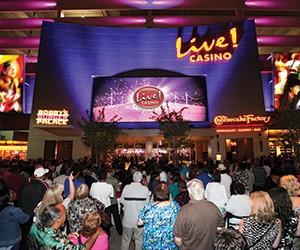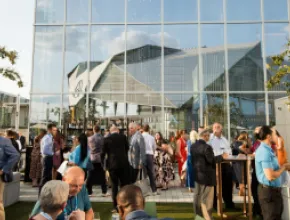Baltimore, Annapolis and the Eastern Shore can take visitors quickly along the gamut of American life, from Baltimore’s big-city downtown to the bustling sailing hub of Annapolis, and on to the beaches of Ocean City or the peaceful, rural reaches of Eastern Shore towns. While everything is within a few hours’ drive, visitors will want to slow down to take in the ambience of a destination whose culture has been shaped equally by land and water.
BALTIMORE
Baltimore’s downtown is home to one of America’s most-visited areas, the Inner Harbor and its crown jewel, the National Aquarium, as well as several notable museums that play a big part in Baltimore’s culture.
The Baltimore Museum of Art, which has the world’s largest collection of works by Matisse, and the Walters Art Museum are just north of the Inner Harbor. Besides these fine-arts hubs, Baltimore is also well known for the American Visionary Art Museum, which showcases inspired but untrained artists, and the Geppi Entertainment Museum, which presents successive generations of pop-culture items such as political cartoons, comic books, movie posters, and Star Wars and Howdy Doody toys. The Geppi also sponsors Zombie Gras, in which visitors volunteer to menace Baltimore’s human population as “zombies” during Mardi Gras.
The War of 1812 played a critical role in Baltimore’s history, and this year marks the bicentennial of that conflict’s end. Fort McHenry, featuring a flag that inspired Francis Scott Key to write The Star-Spangled Banner, anchors a year-long celebration culminating with a 10-day festival in September. Meanwhile, visitors to the Maryland Historical Society can see Key’s original poem under glass.
Tom Noonan, president and CEO of Visit Baltimore, says a confluence of historic events and new venues make Baltimore an appealing destination.
“You’re in a great historical state at a great historical moment,” he says. “A lot of conventions are going to be here, and in slow periods we have major sporting events taking place. And then everything’s two feet away, everything is walkable. The convention center is on the water, all the attractions and museums are there, so it’s easy to do business here.”PageBreak
ANNAPOLIS/ANNE ARUNDEL COUNTY
Annapolis has more 18th century brick buildings than anywhere in the U.S., and one—the Maryland State House—also served as the U.S. Capitol from 1783 to 1784. George Washington resigned as commander of the Continental Army here, and the Treaty of Paris, which ended the Revolutionary War, was signed here as well.
Visitors walking the cobblestone streets of downtown Annapolis will quickly run into beautiful Georgian-style and other historic buildings such as the Chase-Lloyd House, William Paca House and Hammond-Harwood House.
Jo Ellyn McNees, vice president of sales at the Annapolis and Anne Arundel County CVB, says visitors shouldn’t miss the U.S. Naval Academy.
“Navy-Marine Corps Memorial Stadium is a multiuse space that accommodates exhibits, education sessions, banquets, weddings, and meetings and conferences. As an added amenity, groups can use the stadium field to exercise and play their favorite sport.”
Food—and especially seafood—is a big part of life here. Groups seeking an extraordinary culinary experience may want to try an Annapolis Food & History Tour, where participants sample dishes at several of Annapolis’ most popular restaurants and learn about the area’s cuisine and chefs.
Another of Anne Arundel County’s premier attractions is the Historic London Town and Gardens in Edgewater, and its 23 acres constitute Maryland’s largest ongoing archaeological dig. A visitor center here helps orient groups, and attendees will also enjoy various exhibits and a museum.PageBreak
EASTERN AND ATLANTIC SHORES
Just across the Chesapeake Bay Bridge is Talbot County, a swath of farmland and towns boasting 600 miles of shoreline. This area’s largely rural character lets visitors quickly transition from urban bustle, says Cassandra Vanhooser, director of tourism at the Talbot County Office of Tourism.
“In an hour-and-a-half you can be in this paradise of Chesapeake living where life is a bit slower, from the Inn at Perry Cabin to things that are more rustic and rural. It’s a wonderful escape.”
Vanhooser suggests visiting the Chesapeake Bay Maritime Museum on the Miles River in St. Michaels, which includes an 1879 lighthouse and working watercraft that tell the story of the Chesapeake’s people.
Talbot County’s culture was heavily influenced by Quaker settlers, as reflected by the Third Haven Friends Meeting House, a historic structure in Easton that still serves its local congregation. Built in 1684, it is America’s oldest wooden religious structure.
Ocean City’s barrier-island location, beaches, waves and boardwalk have attracted generations of visitors.
“Ocean City is typically known as a family-friendly resort. It’s affordable and has fun things to do, and each year, that’s our focus,” says Jessica Waters, communications manager at the Ocean City CVB.PageBreak
“We have groups of all kinds, from professionals to bikers—our Bike Week brings over 200,000 motorcyclists in September,” she says. “But then multiple professional groups come too because everybody loves the beach.”
While you can still smell salty air, French fries and caramel popcorn on the boardwalk, the city’s north side has seen many transformations, including an outdoor fitness center and areas for bird-watching and sunset yoga.
South of Ocean City is Assateague Island, known for its free-roaming wild horses, and just inland is Berlin, which has 47 buildings listed in the National Register of Historic Places.
Wicomico County also offers visitors a beautiful rural setting. Activities here include kayaking on the Nanticoke River or visiting Bordeleau Vineyards & Winery, about a 15-minute drive from Salisbury. Visitors may enjoy the Nabb Research Center for History & Culture at Salisbury University, which focuses on the history and archeology of the Delmarva Peninsula, and the Ward Museum of Wildfowl Art, home of the world’s largest decoy collection.
Eating here is about freshness and flavor, says Kristen Goller, director of marketing and public relations at the Wicomico County CVB.
“With our strong foundation of farming and fishing, it’s easy to be a locavore,” Goller says. “Our restaurants take pride in sourcing their ingredients from local farmers, growers, dairies and watermen. A visit to an all-you-can-eat crab house is a ‘must-do’ experience during the blue crab season.”






